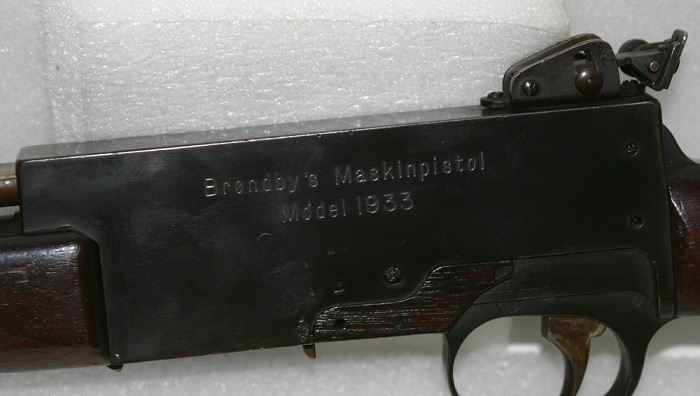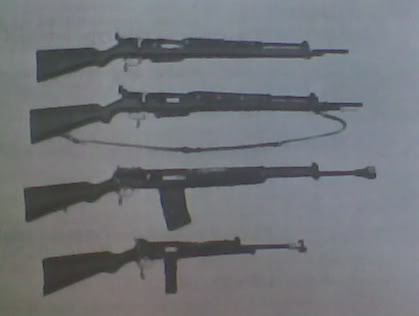Fridtjof Brøndby was a Norwegian arms designer who created a number of self-loading rifle designs in the 1930s, including one which was submitted to the Norwegian Army for testing. He also developed a 7.62mm submachinegun, the Maskinpistol Model 1933. We don’t have much information on Brøndby, but we do have a good set of photos of his 1933 design.


The Model 1933 was a gas-operated, locked breech design, but fired from an open bolt. We can tell that much from the photos, but not a great deal more.
One other photo we have been able to find is an unfortunately small image unearthed by Tony Williams from a British pre-WWII report, which shows the Maskinpistol 1933 along with three other of Brøndby’s designs:

Fridtjof Brondby designed these rifles as well as a light machine gun and 20mm antitank rifle in the 1930s. His M/1937 rifle design was used in Norwegian self-loading rifle trials prior to WWII, but nothing came of the testing before war broke out and the project was dropped.

Do you have more information on Brøndby or his designs? Let us know!
Photos
Brøndby Maskinpistole M/1933 photos (click to download in high resolution)
Patents
US Patent 2,003,066 (F.N. Brondby, “Firearm of the Gas Reloading Type”, May 28, 1935)
US Patent 2,233,671 (F.N. Brondby, “Gas Operated Automatic Firearm”, December 3, 1940)



























What is the muzzle device?… a compensator or a flash hider or a rifle grenade launcher ???
Probably a compensator of some sort. Quite elaborate for a submachine gun, imho.
A lot of interwar firearms were quite elaborate until the war proved the superiority of ones which were dead simple and the easiest to make. It’s par for the course for the 1930s.
7.62 mm… What exactly ammo did it fire?
That’s a very good question…we are working on finding out.
I’d guess it’s rather 7.63×25 mm Mauser, still popular at this time, strong enough to ensure proper operation. .30-18 Auto from Pedersen Device seems to be too weak.
Maybe it is a simple blowback operated…and just because it’s based on rifle, they let the gas tube on place to store some of necessary bolt weight in place of gas piston ??? … just like some Russian AK based SMGs.
Why am I thinking so?…because I think even powerful 7.62x25Mauser cartridge is not strong enough to reliably operate that gas system!?! What do you think guys ?
Well, look at Chinese Type 79. It’s gas operated, it shots 7.62x25mm. And it seems that it works…
On other hand…yes, you are right !
And on the other other hand, no one says, that Brøndby Model 1933 was reliable or otherwise successful weapon. Quite the opposite: since it’s completely forgotten, obscured and has not been adopted by anybody, one may assume, that it was a less or more failed design.
Let’s look at the gas tube. It has a wider front part then it has a shoulder and narrower rear portion.I wonder what is this transition for??? Maybe it is done to store a spring if the gun uses short stroke piston??? Or it’s made to seal the gases by piston head when the piston is on it’s on rear position in order to prevent excessive gases to enter the receiver ?!?
Is there any chance that it might have been chambered for some proprietary cartridge? I tend to agree with what Jasta said, with a twist… Maybe the gun – or the system, as Brøndby seems to have tried to cater to a full set of tactical needs, from the SMG niche to semiauto rifle, to even LMG (though this one wasn’t much more than a heavier version of the selfloader with full auto capability, apparently w/o even a bipod) – was just redundant back in the mid 1930s, when many good, well proved weapons were widely available in the international market. If to that one adds a high unit cost, with involved machining of parts and so, the Norwegian army would have declined due to high prospective production costs.
On the other hand, and looking at the seemingly well made Model 1933 prototype, I doubt this (and the other Brøndby weapons, for that matter) was just a shop prototype. Maybe the Kongsberg Arsenal was somehow involved in the development and/or perhaps Fridtjof Brøndby worked there back.
Leroy Thompson in his book on the sten gun says it was gas operated and was looked at by the British in 1938 who thought it showed promise but was not tested further.